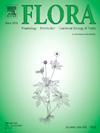揭示影响萼花组分类的叶片解剖特征。萼花(菊科)
IF 1.8
4区 生物学
Q3 ECOLOGY
引用次数: 0
摘要
这是菊科植物萼花属的叶片解剖比较研究的第一篇报道,萼花属具有明显复杂的分类历史。纯粹的结构分析使我们能够区分尚未在该群体的文献中探索的解剖模式。不同类型的毛状体,包括毛状体和腺状体,在该属的分类中提供了信息。其他分泌结构和叶柄中脉维管系统的不同构象模式值得强调,因为这是Calea种的区别,特别是C. serrata和C. pinnatifida这两个形态相似的物种。相似性分析增强了Calea节种间结构的相似性,使其区别于其外群,其叶因缺乏乳汁管和等双侧叶肉而明显。需要组织化学研究来研究由腔、乳汁管、蜜腺和分泌毛状体分泌的代谢物。其中许多结构的化学成分尚未在属中被探索过。我们提出了一个识别密钥和一个二进制/多状态矩阵,可以支持未来在Calea中进行红外分类的建议。本文章由计算机程序翻译,如有差异,请以英文原文为准。
Revealing leaf anatomical characters that impact the taxonomy of Calea sect. Calea (Asteraceae)
This is the first report of a comparative leaf anatomy study of Calea, a genus of Asteraceae with a markedly complicated taxonomic history. The purely structural analyses allowed us to distinguish anatomical patterns that have not yet been explored in the literature of the group. The different types of trichomes, both tector and glandular, are informative in the taxonomy of the genus. The other secretory structures and the different conformational patterns of the vascular system in the midrib and petiole deserve to be highlighted for contributing to the distinction of Calea species, especially C. serrata from C. pinnatifida, two morphologically similar species. The similarity analysis reinforces the structural similarity between the species of Calea sect., distinguishing them from the outgroup, whose leaves are distinct due to the absence of laticifers and isobilateral mesophyll. Histochemical studies are needed to investigate the metabolites secreted by the cavities, laticifers, nectaries and secretory trichomes. Many of these structures have chemical content that has not yet been explored in the genus. We present an identification key and a binary/multistate matrix that can support future proposals for infrageneric classification in Calea.
求助全文
通过发布文献求助,成功后即可免费获取论文全文。
去求助
来源期刊

Flora
生物-植物科学
CiteScore
3.30
自引率
10.50%
发文量
130
审稿时长
54 days
期刊介绍:
FLORA publishes original contributions and review articles on plant structure (morphology and anatomy), plant distribution (incl. phylogeography) and plant functional ecology (ecophysiology, population ecology and population genetics, organismic interactions, community ecology, ecosystem ecology). Manuscripts (both original and review articles) on a single topic can be compiled in Special Issues, for which suggestions are welcome.
FLORA, the scientific botanical journal with the longest uninterrupted publication sequence (since 1818), considers manuscripts in the above areas which appeal a broad scientific and international readership. Manuscripts focused on floristics and vegetation science will only be considered if they exceed the pure descriptive approach and have relevance for interpreting plant morphology, distribution or ecology. Manuscripts whose content is restricted to purely systematic and nomenclature matters, to geobotanical aspects of only local interest, to pure applications in agri-, horti- or silviculture and pharmacology, and experimental studies dealing exclusively with investigations at the cellular and subcellular level will not be accepted. Manuscripts dealing with comparative and evolutionary aspects of morphology, anatomy and development are welcome.
 求助内容:
求助内容: 应助结果提醒方式:
应助结果提醒方式:


